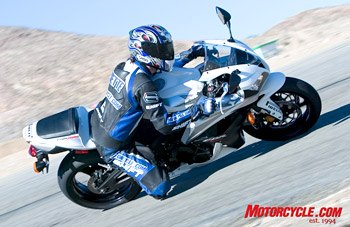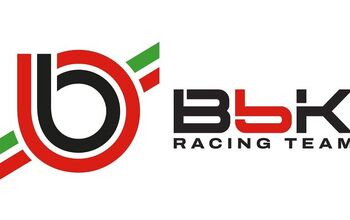Pirelli's Red Devil
Out with old and in with the new. That saying seems tailor-made to talk of motorcycle tires. In this instance the tire we're talking about is the venerable Pirelli Diablo. A favorite of sportbikes owners, trackday riders and even the jaded motorcycle media, the Diablo earned its reputation quickly as a good handling, even-wearing, sticky set of buns that could appease just about all except for the most demanding track rider or racer.
Enter the Diablo's replacement, the Diablo Rosso. Pirelli makes a good case retiring the Diablo. It's not just about the life cycle of a product coming to end in order to wake up the sleepy masses; the Rosso was created in light of the growing demands of today's powerful motorcycles. Let's face it. One hundred horsepower and 80 ft-lbs or more of torque is scrapping the bottom of the barrel these days. Kick it up several notches into the sportbike arena where 150 ponies at the wheel is almost prosaic, slipper clutches abound, ultra-stout chassis relay every grain of sand in the road, and it's easy to see that tire technology must stay ahead of the curve in the performance game.
“Rosso is in the biker who wants an astonishing tire,” reads Pirelli’s press materials, “one that allows him to really exploit the potential of his bike, and allowing them to feel that all while they are making the most of life itself.” The impassioned Italians want to translate their lust for life into their tire, and in doing so are appealing to the riders who sees themselves as a biker as part of their lifestyle. You know who you are. You ride to the market if even for one thing, you commute, you ride on weekends, you ride to the corner Starbuck's, to the video store. From what I was able to distill from all the hype, the Rosso is a tire fashion statement as much as anything.
But what is the Rosso supposed to do that the Diablo didn't? In Pirelli's eyes it'll do everything, only better. Better, that is, except for warm-up time and wear life. The old Diablo and the Rosso purportedly overlap in these areas; otherwise the Rosso claims marked gains in grip (both dry and wet), with even bigger improvements to handling, stability and "versatility," whatever that means. A quick chat with one of the staff from Italy revealed that we can probably expect tire lifespan something on the order of about 5,000 miles, give or take, from the newest member of the Diablo line.
Look at a Diablo and a Diablo Rosso next to one another and you'll note very similar tread patterns. That's due to the fact that the Rosso's pattern is an amalgam of their higher performance Corsa and some new tread tweaks, most notably what Pirelli calls the "nude shoulder." FGD, or "Functional Grove Design" as they call it, allows for "great performance" at full lean in the dry, giving the street rider a "secure feeling."
What Pirelli calls EPT (Enhanced Patch Technology) works in conjunction with FGD and Ideal Contour Shaping (ICS) to give the zero-degree steel-belt radial its responsive handling, stability and its even wear. It’s interesting to note that this tire is not made with their other-worldly manufacturing technology called MIRS (Modular Integrated Robotized System), but is instead manufactured via traditional processes.
The new tire was also allegedly designed with "standard" tire pressures and "standard" suspension in mind in order to meet the demands of so many different bikes.
Pete's Time On The CBR600RR
As fate would have it, I never got around to riding the fabled 2007 CBR600RR this past year. But Pirelli's Rosso intro saved the day, and a quick call to Honda had me in possession of the much-lauded CBR.
After a full day of street and track time, I could plainly see why so many people raved about this bike. It may be one the most responsive motorcycles I've ridden. The chassis seems to anticipate your thoughts and changes direction with the slightest input, yet it's far from being a sketchy ride. Honda did a beautiful job of blending ultra-responsiveness with confidence-inspiring stability. Braking performance is outstanding, too, especially in street riding environs. They have very good initial feel and linear power. A day at the track exposed a little bit of brake fade, but nothing that a small investment in some stainless steel lines couldn't fix.
And of course there's that power that really got everyone excited. Yep, it has all the mid-range power you may have read about. The mill pulls surprisingly strong from as early 3K rpm, with a bit of a soft zone somewhere around 5,000 to just about 7,000. But the thing pulls like a much bigger bike once 9 grand comes around, and it accelerates rapidly all the way to its 15,000-rpm redline. Twist the throttle anywhere after 9,000, and the CBR zips away quickly. Fueling was essentially flawless but required a deft hand when trying to modulate openings at lower revs while negotiating a turn. At that point it has a bit of an electronic feel, like it’s either on or off. Otherwise, grabbing a handful on this thing is nothing but fun. Best of all, this razor sharp supersport is actually all-day comfortable. The ergos say, "ride me,” not just "win on me!"
My suspicion is that if Josh Hayes had not had a bad run of get-offs this season, Honda's CBR600RR would have easily taken the AMA Supersport title.
All the slickest acronyms and best whiskey in the world won't mean a thing if the demanding motorcycle media can't be convinced that a new product is really "new and improved." Pirelli set up a 150-mile street ride replete with lots of local twisty roads and plenty of straight slab to get the everyman's street impression. At the end of the rainbow was the better part of five hours of track time on the chunky and bumpy Streets of Willow at Willow Springs Raceway in Rosamond, CA, where a day of absolutely ideal weather awaited us.
'Like its performance on track, the tire was excellent.'
I had the unusual opportunity to ride the outgoing Diablo back-to-back with the new Rosso, and I was able to discern that the Rosso does indeed pick up a skosh more grip than the Diablo. The early part of the day started on the Diablo in the rather brisk temps of the mountainous roads that climb out of Ojai, CA. I encountered a minor slip and wiggle from the ol' Diablos and was reminded that these aren't gummy race tires. After that reality check, though, I didn't feel worse for the wear, as the Diablo is – or, rather, was – a very good tire and deserving of all the accolades heaped upon it over the past couple of years. Stability and side-to-side transitions are very good on the retiring Diablo as I had high-speed shenanigans and curves o’plenty to test these characteristics.
The other half of my street time was on the Rosso. Like its performance on track, the tire was excellent. Constant illegal speeds down the freeway never resulted in any unwanted shimmies or speed wobbles; nor was the ride harsh. What they offered instead was the sense of a really good set of tires connecting my bike to the road.
As for the Rosso's track performance, from my perspective there's little fault finding. Since I'm not a tire-roasting hotshot who can qualify on an AMA Supersport grid, my impressions are probably closer to what most of you will encounter (but I'm not saying I'm the slowest guy out there either!).
After the first cautious session of the day was used for scrubbing in shiny new meat, the second and third sessions told me a lot of what I need to know for my riding level. With at least 20 minutes between the two different riding groups, the Rossos had plenty of time to cool down. Yet on the first lap out in my third go-'round I was able to get down and as aggressive as ever by about the third turn. Translation: The tire came up to operating temperature quickly, with overinflated-for-the-track tire pressure no less. Once I bled them down to roughly 31 psi front and rear, the bike felt like a cat on Velcro.
The Rossos wore consistently throughout the day, showing little sign of serious deterioration even after I let a fellow true racer-boy journo spend a session on my bike. At the end of the day the tires looked as though they could easily withstand another full day at a minimum of torture at the track and still allow for many more street miles. Simply speaking, they looked almost new.
Although I didn't query the other riders in attendance, I didn't hear any murmurings of poor performance from any of them. Some banter between the really fast riders (guys who actually have qualified on AMA girds!) revealed that at day's end the tire started to get a little greasy. Hours and hours of caning on the track by riders pushing the envelope finally saw the Rosso reach its useful limits for said environment. But the aforementioned riders aren’t really who Pirelli expects to buy this tire. For such abuse you should be looking at the racier Corsa III and Supercorsas. All that being said then, the Red Devil is most certainly capable of carrying on in the Diablo's tradition of great tires.
The Rossos will come in a wide selection of sizes, from 110/70 x 17 fronts all the way up to the chubby 190/50 x 17 rears. For now, the sizes that will be available starting the end of November will be the 180s/190s. The standard Diablo will still fulfill the needs of the smaller sizes (110s and 150s for example). Pricing is said to be 10-15% above the departing Diablo's retail cost.
Pete's Panoply
- SHIFT SR-1 one-piece leather suit
- SHIFT SR-1 leather gloves
- Alpinestars SMX road race boots
- Shoei RF-1000 Nerve (blue)
More by Pete Brissette





























Comments
Join the conversation